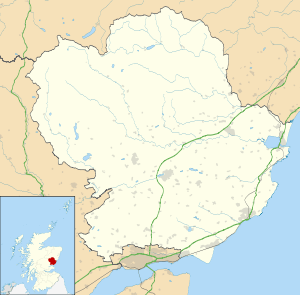Glamis
Coordinates: 56°36′29″N 3°00′13″W / 56.608128°N 3.003473°W
Glamis /ˈɡlɑːmz/ is a small village in Angus, Scotland, located four miles south of Kirriemuir and five miles southwest of Forfar. It is the location of Glamis Castle, the childhood home of Queen Elizabeth the Queen Mother.
History

The vicinity of Glamis has prehistoric traces – within the village there stands an intricately carved Pictish stone known as the Glamis Manse Stone. There are various other Pictish stones nearby the village, such as the Hunter Hill Stone, and the Eassie Stone, which stands in the nearby village of Eassie.[1] The last Alpínid king of Scotland, Malcolm II, died at Glamis in 1034.[2]
The humorous poet Agnes Lyon lived here.[3]
Important buildings

Glamis is a well-preserved conservation village. Glamis houses the Angus Folk Museum run by the National Trust for Scotland. This is a museum of days past, recreating scenes of rural life such as a minister's parlour; a schoolroom; a laundry; and an agricultural area, along with displays of tools, everyday artifacts, and old crafts. It is housed in an adapted row of single storey stone cottages.
The parish church of Glamis, dedicated to Saint Fergus, was founded in the early medieval period (probably 8th century AD). The present building is 18th-century with restoration in the 1930s but retains a vaulted 15th-century aisle from the medieval church which preceded it. In an aisle of the parish church is the burial place (photo) of the Bowes-Lyon family, owners of Glamis Castle. One of its park gates is situated near the parish church.[4]
The castle hosts various events throughout the year, notably the Proms evening when thousands of people traditionally turn out with picnics ranging from the small to the elaborate.
Glamis in Shakespeare
In the tragedy of Macbeth by William Shakespeare Macbeth is the Thane of Glamis and later the Thane of Cawdor.
At the start of the play, the protagonist, Macbeth, is the thane of Glamis & has just been made Thane of Cawdor, although he doesn't know that he is Thane of Cawdor as the play is set in the Middle Ages so news travels slowly. Being Thane of Cawdor makes him third in line to the throne, and he later commits regicide to fulfill the witches' prophecy:
"All hail Macbeth! Hail to thee, Thane of Glamis!" "All hail Macbeth! Hail to thee, Thane of Cawdor!" "All hail Macbeth, that shalt be king hereafter!"
This means that despite being only a small village, the popularity of naming residential streets after Shakespearean characters & locations in Victorian times means that several cities in the UK have streets named after Glamis.
See also
- Ark Hill
- Castleton
- Charleston
- Eassie Stone
- Glamis Castle
- Lord of Glamis
- Monster of Glamis
- Wester Denoon
References
- ↑ C.Michael Hogan, Eassie Stone, The Megalithic Portal, ed. Andy Burnham, Oct. 7, 2007
- ↑ Black's Picturesque Tourist of Scotland, Adam and Charles Black, Published 1861, Scotland, 635 pages
- ↑ J. C. Hadden, ‘Lyon, Agnes (1762–1840)’, rev. Sarah Couper, Oxford Dictionary of National Biography, Oxford University Press, 2004 accessed 31 Jan 2015
- ↑ https://books.google.co.uk/books?id=0JEZAAAAYAAJ&pg=PT279&lpg=PT279&dq=Earl+of+Strathmore+and+Kinghorne+burial&source=bl&ots=AwQOmFMdeL&sig=n_8hNrpLqaTl3EulBJJgcczmSr0&hl=de&sa=X&ved=0ahUKEwj0voLM9KbLAhWC1hQKHVSlAa44ChDoAQgaMAA#v=onepage&q=Earl%20of%20Strathmore%20and%20Kinghorne%20burial&f=false
| Wikimedia Commons has media related to Glamis. |
| Wikisource has the text of the 1911 Encyclopædia Britannica article Glamis. |
